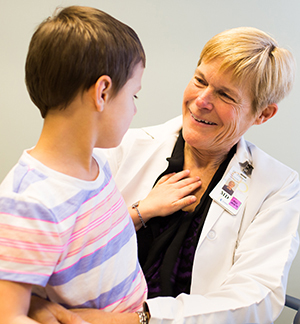From www.childrenshospitals.org
While I had been routinely discussing my patients’ brains and treatment options, a mass had been growing inside my own.
By Mary L. Zupanc, M.D.

Mary Zupanc’s experience changed her as a physician and person.
Mary, I think you had a seizure. Those were my husband’s words as he woke me one early winter morning. He had to be mistaken. As a pediatric epileptologist, I devoted my life to understanding, preventing and treating seizures in children. Surely, I would know if I’d had a seizure. But moments later, when I noticed the rumpled sheets, registered my achy body and saw the fear on his face, I knew he was right.
Throughout my career, I’ve watched seizures affect young children and their families. The satisfaction of bringing them relief through a correct diagnosis and medication is unending. But when medications fail and the conversation turns to brain surgery, everything shifts.
Parental fear and misunderstanding stop many from pursuing surgical intervention, though up to 70 percent of these children will benefit. To guide parents’ decisions, I remind them that other treatments haven’t reduced their child’s seizures in number or severity; explain the gravity of prolonged seizures; and discuss surgical risks. Their questions are often similar: How risky is it? Will surgery leave lasting effects? Can we try different medications?
Suddenly, I found myself asking those same questions of my own physicians. An MRI showed a bifrontal meningioma, a tumor in the brain’s lining that’s rarely cancerous but can lead to memory loss, personality changes and seizures. I was stunned. While I had been routinely discussing my patients’ brains and treatment options, a mass had been growing inside my own.
Looking back, it made sense. A lifelong runner, I added more than an hour to my marathon time. My legs felt heavy and slow. I’d gained weight for no reason, and I was perpetually exhausted. Symptoms worsened even after a barrage of tests that summer showed perfect health. By fall, I had trouble focusing my left eye. The day before my seizure, I noticed I couldn’t smell the flowers that normally perfumed my morning jog.
By the time I received my MRI results, my symptoms were worsening. Like many of my patients, surgery was the only option. The concerns I’d heard from patients and families took on a new dimension. Now, they were mine, and the data and statistics I once prized did not provide much relief.
A young person’s brain plasticity is a huge asset during surgery, I would tell parents. But my brain was more than 60 years old, I told myself. Anxious thoughts clouded my mind: What if I died in surgery? What if I lived but was no longer the same person?
Surgeons removed a two-inch tumor from my brain. They estimated it had been growing for at least 10 years, maybe even 20. After recovery, I returned to work and noticed a difference immediately. My symptoms gone, I felt softer and more patient. Being truly vulnerable for the first time changed my outlook on life and my practice.
This forever altered me as a physician and person. After years of relying on facts and figures, I now first consider a personal connection. Parents and patients need a physician, but they also need an advocate, an ally and a partner. That’s when I share my story. I want them to know they’ll never be alone on this journey.











